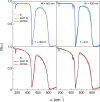High conductivity of ultrathin nanoribbons of SrRuO3 on SrTiO3 probed by infrared spectroscopy
- PMID: 30315227
- PMCID: PMC6185982
- DOI: 10.1038/s41598-018-33632-3
High conductivity of ultrathin nanoribbons of SrRuO3 on SrTiO3 probed by infrared spectroscopy
Abstract
SrRuO3 (SRO) is a perovskite increasingly used in oxide-based electronics both for its intrinsic metallicity, which remains unaltered in thin films and for the ease of deposition on dielectric perovskites like SrTiO3, (STO) to implement SRO/STO microcapacitors and other devices. In order to test the reliability of SRO/STO also as high-current on-chip conductor, when the SRO dimensions are pushed to the nanoscale, here we have measured the electrodynamic properties of arrays of nanoribbons, fabricated by lithography starting from an ultrathin film of SRO deposited on a STO substrate. The nanoribbons are 6 or 4 nm thick, 400, 200 and 100 nm wide and 5 mm long. The measurements have been performed by infrared spectroscopy, a non-contact weakly perturbing technique which also allows one to separately determine the carrier density and their scattering rate or mobility. Far-infrared reflectivity spectra have been analyzed by Rigorous Coupled-Wave Analysis (RCWA) and by an Effective Medium Theory, obtaining consistent results. With the radiation polarized along the nanoribbons, we obtain a carrier density similar to that of a flat film used as reference, which in turn is similar to that of bulk SRO. Moreover, in the nanoribbons the carrier scattering rate is even smaller than in the unpatterned film by about a factor of 2. This shows that the transport properties of SRO deposited on STO remain at least unaltered down to nanometric dimensions, with interesting perspectives for implementing on-chip nano-interconnects in an oxide-based electronics. When excited in the perpendicular direction, the nanoribbons appear instead virtually transparent to the radiation field, as predicted by RCWA.
Conflict of interest statement
The authors declare no competing interests.
Figures





References
-
- Mackenzie AP, et al. Observation of quantum oscillations in the electrical resistivity of SrRuO3. Phys. Rev. B. 1998;58:R13318–R13321. doi: 10.1103/PhysRevB.58.R13318. - DOI
-
- Kaur P, Sharma KK, Pandit R, Choudhary RJ, Kumar R. Structural, electrical and magnetic properties of SrRuO3 thin films. Appl. Phys. Lett. 2014;104:081608–081612. doi: 10.1063/1.4866775. - DOI
-
- Majcher AM, Rode K, Coey JMD, Stamenov P. Magnetic, transport and structural properties of SrRuO3 thin films. J. Appl. Phys. 2014;115:179901–179904. doi: 10.1063/1.4871336. - DOI
-
- Vailionis A, Siemons W, Koster G. Strain-induced single-domain growth of epitaxial SrRuO3 layers on SrTiO3: A high temperature x-ray diffraction study. Appl. Phys. Lett. 2007;91:071907–071909. doi: 10.1063/1.2771087. - DOI
-
- Koster G, et al. Structure, physical properties and applications of SrRuO3 thin films. Rev. Mod. Phys. 2012;84:253–298. doi: 10.1103/RevModPhys.84.253. - DOI
Grants and funding
- Ateneo/Sapienza Università di Roma (Sapienza University of Rome)
- Ateneo/Sapienza Università di Roma (Sapienza University of Rome)
- Ateneo/Sapienza Università di Roma (Sapienza University of Rome)
- ateneo/Sapienza Università di Roma (Sapienza University of Rome)
- Ateneo/Sapienza Università di Roma (Sapienza University of Rome)
LinkOut - more resources
Full Text Sources

